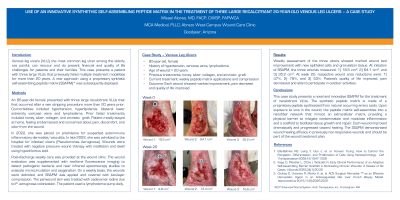Case Series/Study
(CS-006) Use of an Innovative Synthetic Self-Assembling Peptide Matrix in the Treatment of Three Large Recalcitrant 20-Year Old Venous Leg Ulcers- A case study

Venous leg ulcers (VLU), the most common leg ulcer among the elderly, are painful, can reoccur and do present financial and quality of life challenges for patients and their families. This case presents a patient with three large VLUs that previously failed multiple treatment modalities for more than 20 years. A new approach using a proprietary synthetic self-assembling peptide matrix (SSAPM)* was subsequently deployed.
Methods:
An 85-year-old female presented with three large recalcitrant VLUs that first occurred after a vein stripping procedure more than 20 years prior. Co-morbidities included hypertension, hyperlipidemia, bilateral lower extremity varicose veins and lymphedema. Prior failed treatments include honey, silver, collagen, hyperbaric oxygen and amniotic graft. Patient mostly stayed at home, feeling embarrassed and concerned about pain, discomfort, and odor from the wound.
In 2022, she was placed on prednisone for suspected autoimmune inflammatory dermatitis/vasculitis. In late 2022, she was admitted to the hospital for infected ulcers (Pseudomonas aeruginosa). Wounds were treated with negative pressure wound therapy.
Post-discharge weekly care was provided at the wound clinic. The wound evaluation was supplemented with real-time fluorescence imaging to detect pathogenic bacteria and near infrared spectroscopy studies to evaluate microcirculation and oxygenation. On a weekly basis, the wounds were debrided, and SSAPM was applied and covered with two-layer compression. The periwound skin was treated with cadexomer iodine due to P. aeruginosa colonization. The patient used a lymphedema pump daily.
Results:
Weekly assessment of the three ulcers showed marked wound bed improvement with new epithelial cells and granulation tissue. At initiation of SSAPM, the three wounds measured: 1) 18.5 cm2, 2) 64.1 cm2, and 3) 35.2 cm2. At week 20, respective wound area reductions were: 1) 47%, 2) 79%, and 3) 53%. Patient's quality of life improved, pain decreased and able to participate in outdoor activities.
Discussion:
This case report presents a novel and innovative SSAPM for the treatment of recalcitrant VLUs. The synthetic peptide matrix is made of a proprietary peptide synthesized from natural occurring amino acids. Upon exposure to ions in the wound, the peptide matrix self-assembles into a nanofiber network that mimics an extracellular matrix, providing a physical barrier to mitigate contamination and modulate inflammation and a scaffold to facilitate tissue growth and repair. Each wound improved dramatically and progressed toward healing. The SSAPM demonstrated wound healing efficacy in previously non-responsive wounds and should be part of the wound treatment plan.
Trademarked Items:
References:

.png)